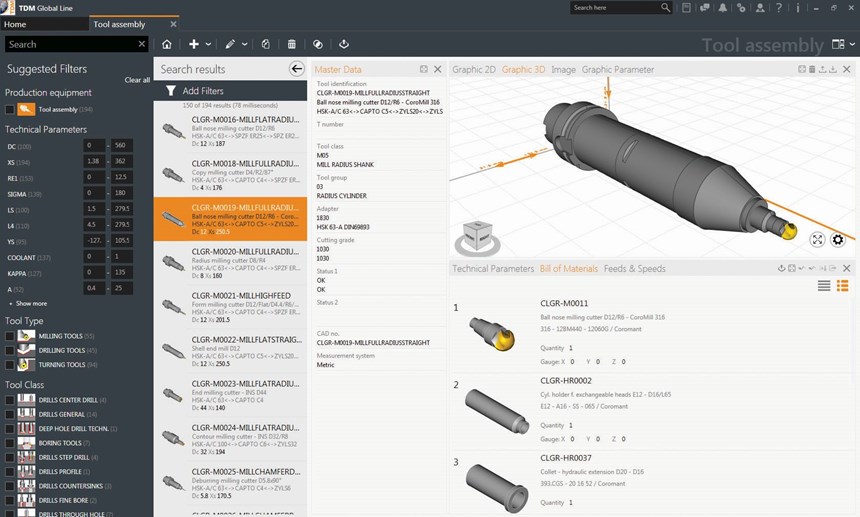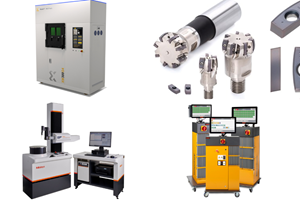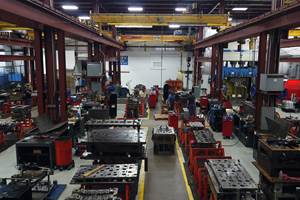Cutting Tool Data When You Need It
From the tool crib to enterprise resource planning systems, tool lifecycle management breaks down expensive data silos.
Share
Read Next
There are a lot ways to make a shop better, more efficient, more productive and more profitable, but one practical method that is often overlooked is tool lifecycle management. This is about more than cutting tools. Fundamentally, it’s about data: ensuring that cutting tool data is available where and when it is needed. It links CAM systems, presetting and crib systems, and machine controls. It can also extend upstream to the planning and execution levels, including production, planning and control systems (PPS), and enterprise resource planning (ERP) and manufacturing execution (MES) systems.
To extend so widely, tool lifecycle management software must be “open” and able to supply numerous import and export interfaces. It also must be able to integrate data from various sources, such as catalogs from cutting tool manufacturers or 3D models created in house, into a centralized database.
Ultimately, tool lifecycle management impacts the entire machining process, from the selection of cutting tools to their use in production planning to seamless transfer and use on the shop floor. Information from the individual process steps continuously flows back to a centralized database, creating a growing mass of valuable data that’s accessible throughout the networked system.
Standards for this exchange of cutting tool data is important.They include ISO 13399, a set of international standards that enables cutting tool manufacturers to use the same language to describe their products in a digital format; generic tool catalog (GTC), a complement to ISO 13399 that enables productive data exchange between cutting tool vendors and applications; and MTConnect, a standard that enables manufacturing equipment to provide data in a structured XML format rather than proprietary formats.
These standards are only part of the solution, however. Because it is not just storing the data, but efficiently searching for and finding the right data that is critical, as well as providing that data to other systems that need it. The right tool lifecycle management software should have options that extend from managing the tool crib to interfacing with other systems, such as those for purchasing or CAM programming.
Examining the Problem
Companies often rely on a CAM system’s generic cutting tool models, but they may pay a price for that. How many times have you seen programmers leave their desks and go to the shop floor to ask, “Do we have something like this?” Remember, if your NC programmers can’t search the access database for information about the contents of the tool crib, they will need to get up and physically look for the cutting tool or tools in question. The result is lost time.
Using actual cutting tool graphics contained in tool lifecycle management software, not generic cutting tool models, takes the guesswork and uncertainty out of cutting tool creation. When individual cutting tool assemblies and items are specifically identified, you can achieve efficient and repeatable accuracy. This will be particularly evident in high-speed milling, where knowledge of cutting tool weight and balance are critical to success.
Other questions that arise during cutting tool selection include which tools are best suited for which process steps? Which combinations are most efficient? Tool lifecycle management software helps designers quickly answer these questions by providing basic information on cutting tools and their potential applications. Along with helping with cutting tool selection for each NC operation, the software stores geometry and cutting data for each cutting tool assembly, makes 3D tool graphics available for NC and simulation analyses, and saves cutting tool lists from the NC programs for future use. In addition, the recording of cutting data, machining conditions and best practices permits the optimization of cutting tool use in future applications.
When it comes to presetting, precision is important. Tool lifecycle management software offers presetters access to the nominal data for each cutting tool assembly and then transfers the actual measured data back to the software so that the database can be continually fine-tuned. The cutting tool data and NC programs, together with the actual preset tool data, simultaneously are sent to the correct machine via direct numerical control (DNC).
Radio frequency identification (RFID) chips are another possibility for transferring tool data to the machine. Machine downtime reduction and damage prevention through electronic generation of machine-specific tool offsets, based on the actual tool data, are two benefits of connecting presetting in your tool lifecycle management software.
Centralizing Data
Information contained in higher-level systems such as MES often operate as isolated “silos” of data. For example, purchasing has its own silo, CAM has its own silo, and tool cribs have their own silo. This means that a great deal of time is wasted recreating data. A central database for that information is needed. It will not replace your purchasing system or CAM system, but tool lifecycle management software can become the easily accessed repository for vital cutting tooling data. You can have one central data point that these systems are directly connected to or an online interface to the same information. Keep in mind that the centralized database replaces the cost of all these homegrown systems or silos that must be maintained, so total cost of ownership is reduced.
Cutting tools are capital-intensive production resources, so a global view of your cutting tooling world using tool lifecycle management software will allow work-in-progress inventory and actual crib inventories to be kept low, orders to be initiated at the ideal time, and cutting tool variety to be minimized. Cutting tools account for 8 to 12 percent of manufacturing cost. Tool lifecycle management software, might allow you to make use of five cutters instead of 20. This reduction in cutting tool variety and vendors reduces overhead and can decrease your cutting tooling budget by 20 to 30 percent.
This centralized database also provides data integrity, reduced effort and total transparency. Direct access to cutting tool data and graphics supports the tool selection in NC programming. Cutting tools can also be selected by tool class/group or machining process, and be sent via the interface to the NC program. Users also have access to geometry data, 2D and 3D graphics of assemblies, feeds and speeds information, and collision data. When the NC program is completed, the cutting tools used in the program can be saved in the tool lifecycle management software, allowing the crib to assemble, preset and deliver the cutting tools to the machine as the programmers intended. And now, with a move to cloud storage, you can run your tool lifecycle management software and access the database on a computer, laptop, smartphone or tablet.
This is especially applicable for the moldmaking industry, with its extensive use of high-speed milling. In those cases, quick and easy access to CAM simulation tool graphics, collision avoidance and other software tools is particularly valuable. Also, process integrity, precision and reusable asset data supplied by tool lifecycle management software can reduce setup time, particularly on high-end cutting tools, and results in faster time to market.
Related Content
How to Automate Process and Design
Moldmakers can improve their operations and stop wasting time by taking these six steps for process and design automation.
Read MoreProducts and Services for Multiple Moldmaking Needs
New year, new technology roundup! Featured here is a collection of product offerings, from profile milling cutters to industry-specific CAD/CAM software to innovative hot work tool steels.
Read MoreIndiana Mold Builder Decatur Mold Offers a History of Grit and a Future of Innovation
Decatur Mold Tool and Engineering Inc. serves as a tooling tour guide, helping busy tooling managers reduce uncertainty, lighten workload.
Read MoreTake Time to Save Time: 6 Steps in Mold Design to Reduce Back-End Troubleshooting
Westminster Tool shares how the one week it typically takes to perform these six steps in the design phase can save three weeks or more in an overall tool build.
Read MoreRead Next
How to Use Continuing Education to Remain Competitive in Moldmaking
Continued training helps moldmakers make tooling decisions and properly use the latest cutting tool to efficiently machine high-quality molds.
Read MoreHow to Use Strategic Planning Tools, Data to Manage the Human Side of Business
Q&A with Marion Wells, MMT EAB member and founder of Human Asset Management.
Read MoreAre You a Moldmaker Considering 3D Printing? Consider the 3D Printing Workshop at NPE2024
Presentations will cover 3D printing for mold tooling, material innovation, product development, bridge production and full-scale, high-volume additive manufacturing.
Read More











.jpg;maxWidth=300;quality=90)











